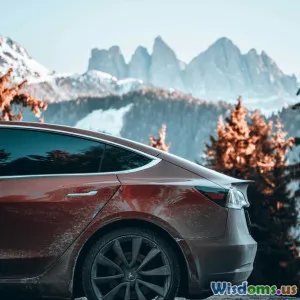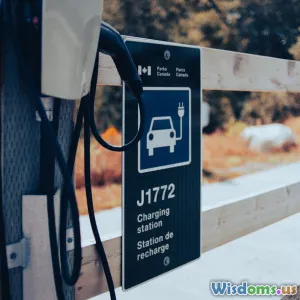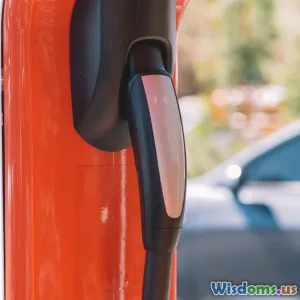
Mastering Winter Driving Tips for Electric Vehicle Owners
8 min read Unlock expert winter driving tips tailored for electric vehicle owners to enhance safety, efficiency, and performance in cold weather. (0 Reviews)
Mastering Winter Driving Tips for Electric Vehicle Owners
As winter approaches, many electric vehicle (EV) owners face unique challenges that differ significantly from traditional gasoline cars. Cold weather affects everything from battery efficiency to tire traction, significantly altering your EV’s performance and driving range. But don’t let the frost and snow freeze your confidence behind the wheel—understanding how winter impacts your electric ride is the first step to mastering winter driving with your EV.
Whether you’re a seasoned EV driver or new to this green tech, this comprehensive guide dives deep into weather-proofing your EV’s operation, addressing common concerns, and delivering actionable tips to keep you safe and efficient in ice, snow, and freezing temps.
Why Winter Driving Is Different for Electric Vehicles
Unlike combustion engines, electric vehicles rely heavily on battery power, which is sensitive to temperature extremes. According to the U.S. Department of Energy, EV range can decline by 20% to 40% in cold conditions. This drop is due to slower electrochemical reactions in the battery and additional energy used to heat the cabin.
Furthermore, regenerative braking systems operate differently in icy conditions, necessitating adapted driving techniques. Understanding these distinctions equips EV owners to take informed action toward safer winter journeys.
1. Understanding the Impact of Cold Weather on EV Batteries
Battery Chemistry and Temperature Effects
Lithium-ion batteries, commonly used in EVs, experience slower chemical reactions when exposed to cold. This can reduce the battery’s ability to deliver energy efficiently, lowering your effective driving range drastically. For example, a 2022 study by AAA found that in temperatures around 20°F (-6.7°C), EVs lost roughly 41% of their range.
Thermal Management Systems
Modern EVs often include battery thermal management systems (BTMS) to maintain optimal battery temperature. Tesla’s Model 3 and the Chevrolet Bolt EV, for instance, use liquid cooling and heating to preserve battery health and performance.
As an owner, allowing your EV to warm up while still plugged in—using scheduled pre-conditioning—is a proven way to conserve battery charge and improve range when you hit the road.
2. Practical Tips for Maximizing Range in Winter
Pre-Condition Your Vehicle
Pre-condition your EV while it’s still plugged in at home or a charging station. Activating climate control warms the cabin and battery without drawing on battery reserves, thereby preserving maximum range for the drive.
Limit Rapid Acceleration
Aggressive speed changes demand more power, draining your battery quickly. Gentle acceleration and maintaining steady speeds help conserve energy and improve traction.
Use Eco-Driving Modes
Many EVs offer specialized driving modes—like Nissan LEAF's "Eco Mode"—which can limit power output and optimize energy consumption during cold weather.
Manage Heating Usage
While cabin heating may drastically reduce your range, heated seats, steering wheels, and utilizing seat warmers instead of the full HVAC system help maintain comfort with less energy depletion.
Tire Considerations
Switching to winter tires is critical. EVs are heavier than conventional vehicles due to battery packs, so winter tires designed for such loads improve traction and safety on icy roads.
The Rubber Manufacturers Association notes proper winter tires can reduce stopping distances by up to 30% in snow and ice compared to all-season tires.
3. Safety Strategies Specific to EV Winter Driving
Anticipate Road Conditions
Due to the heavier weight and instant torque of EVs, slick or icy surfaces may catch drivers off guard. Increase following distances and reduce speeds to compensate for longer stopping times.
Regenerative Braking Adjustments
Regenerative braking systems can hamper control on slippery surfaces because of torque applied when lifting off the accelerator. Some EVs let drivers adjust the level or disable regen braking temporarily in winter modes.
Charging in Cold Weather
Cold temperatures can slow charging speeds. Using Level 2 chargers or DC fast chargers in heated garages or sheltered areas can alleviate this effect. Planning ahead for charging stops is critical during long winter trips.
Emergency Preparedness
Carry winter emergency kits tailored for EVs—including portable chargers, insulated blankets, and traction mats—to stay prepared if you get stranded.
4. Real-World Insights and EV Winter Performance
A 2023 field test conducted by the Norwegian University of Science and Technology showed Tesla Model Y retaining approximately 70% of its standard range at -10°C. Drivers who used scheduled pre-conditioning and avoided rapid acceleration saw notably better outcomes.
Early adopters in snowy climates like Scandinavia and Canada emphasize the importance of understanding regenerative braking’s quirks and adopting winter tires to navigate safely. EV drivers have also praised the convenience of the instant heating systems compared to waiting for traditional engines to warm up.
Conclusion: Empowering EV Drivers Through Cold Weather Mastery
Winter driving with an electric vehicle requires awareness, preparation, and adapted techniques. By understanding how cold temperatures impact battery performance, range, and vehicle control, EV owners can confidently face seasonal challenges without sacrificing safety or efficiency.
Key actions like pre-conditioning while plugged in, using appropriate tires, moderating acceleration, and planning charging stops enable EV drivers to harness the full potential of their vehicles—even on the iciest roads. Winter doesn’t spell the end of effortless electric driving; instead, it calls for smart adjustments and knowledge, transforming every cold commute into a managed, eco-friendly journey.
As electric vehicle technology continues advancing, ongoing innovations in battery chemistry and thermal management promise even better winter resilience. Until then, mastering these winter driving tips ensures you stay safe, warm, and charged up for every voyage.
Sources:
- U.S. Department of Energy - "Cold Weather and Electric Vehicles"
- Rubber Manufacturers Association - "Winter Tire Safety Facts"
- Norwegian University of Science and Technology - EV Winter Range Study (2023)
- AAA - EV Battery Performance in Cold Temperatures (2022)
Rate the Post
User Reviews
Popular Posts



















